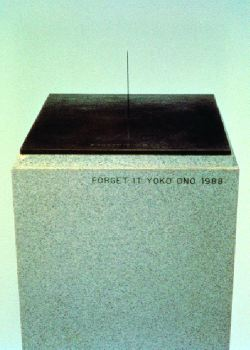Yoko Ono
Japan Society, New York, USA
Japan Society, New York, USA

Yoko Ono's first travelling retrospective, entitled 'Yes', was curated by Alexandra Munroe and Jon Hendricks and offers long-overdue consideration to an artist who was one of the pioneering women working in body-based performance and experimental film. Ono's performances in the mid-1960s with John Cage, George Maciunas and Norman Seaman at legendary venues such as the Judson Memorial Church in New York fix her permanently within Fluxus, even though her solo actions have had more historical resonance. Her seminal work Cut Piece (1965), for example, for which she invited an audience to cut off her clothing, is forever imprinted on the collective unconscious of postmodern feminism.
Alluringly simple, Ono's early works from the 1960s, which are known loosely as 'Instruction Paintings and Objects', are concerned with action, balance and response. Some, such as Smoke Painting (1961/62) - a burnt canvas accompanied by instructions that declare the painting 'over' when the whole canvas has been consumed - are performative gestures. Others invite the viewer to complete the work. Many of her objects ask for help, such as Mend Piece (1966/68), which consists of a broken cup, needle, thread, glue and a note which instructs 'Ask others to Mend'. Forget It (1988), a single needle pointed up, encased within a glass vitrine, combines frustration with a certain singularity, enticing focus and contemplation. Juxtaposing process-oriented objects with short poetic texts and titles, these early works possess an oddly beautiful, austere unity. Comparatively, much of her later work, particularly the bronzed versions of these early objects which she cast in the 1980s, is heavy-handed and inappropriate - like reproducing an old idea so that it won't disappear, they entirely negate her original intentions about ephemerality.
Ono's documented performances and films deal primarily with sexuality and resistance. Rape (1969) is a 77-minute psychologically inflammatory piece that follows an unwilling girl through the streets of London and culminates in her eventually being trapped in her apartment. Fly (1970) follows a house fly mapping an impassive nude female body, probing orifices and triumphantly dominating one nipple, rubbing its wiry legs with greedy, seemingly eager movements. Ono's accompanying soundtrack is wonderfully difficult to bear, a screechy libretto that mimes the shrill buzz of a fly with punk sensibility.
Ono's relationship with John Lennon has limited the terms in which her individual career has been considered. It is unfortunate, then, that portions of this show are equally restricted. For example, rather than offering a formal introduction to Ono's work, the wall label for Ceiling Painting (YES Painting) (1966), the sculpture from which the exhibition draws its name, describes the piece as the catalyst for her first encounter with Lennon. Displayed prominently in the first room, this kind of memorabilia is trivializing and irrelevant, a biographical slanting of her work that continues throughout the wall texts and climaxes in a large room devoted to her collaborations with Lennon.
Throughout her career Ono has been daring and experimental, fully engaged in disparate media, with some outcomes naturally more successful than others. Along with Shigeko Kubota and Yayoi Kusama, other feminist Japanese artists of her generation whose practice has also been diverse, Ono's body-based performances anticipated those of Vito Acconci and Chris Burden, but somehow became secondary to them a generation later. This exhibition attempts to site and validate her practice primarily within Fluxus, but Ono's collaborative and solo works began in Tokyo before her New York performances. Sharing a stage or press release should not automatically subsume her into a movement with which she was only loosely affiliated.
























